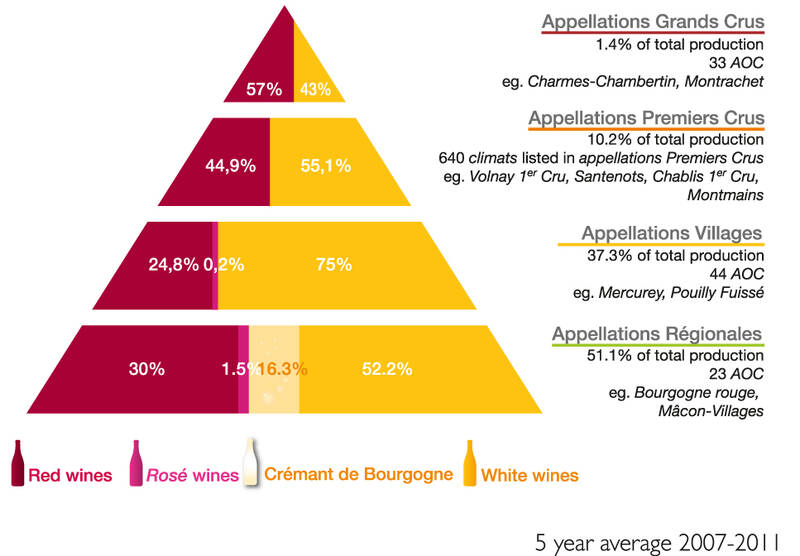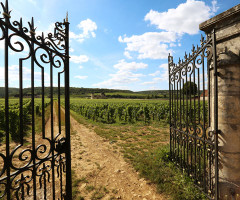Introduction to Burgundy
Posted by EWWines on 5th May 2023
Burgundy is one of the most famous wine regions of the world and is close to our hears at Ellis Wharton Wines. It is easy to see why; Burgundy is a gastronomic paradise which producing many of the world's finest wines and has for hundreds of years, since the Roman times. Many of the regions famous churches, castles and landmarks are still standing from these times and add to the special atmosphere of the region.
The Geography of Burgundy is gentle rolling hills with some steeper slopes and hilltop forests both of which contribute to the perfect wines of the region. The steepness, aspect of the slope and soil play fundamental roles in the appellation and help sculpt the famous quality hierarchy of the region. Our top tip is a wobbly cycle tour through the region along the Routes des Grands Crus to fully appreciate Burgundy’s unique geography and maximise your opportunities to taste as widely as possible to really understand the region! Alternatively, we are hosting an Olivier Laflaive Tasting on the 19th May 2023.
Get your tickets here, last few remaining! or Browse our full Burgundy list here.
The Climate of Burgundy
In land locked central France about 2 hours to the South of Paris or an hour North of Lyon, Burgundy has a continental climate which typically creates hot summers and cold winters, perfect for viticulture. Burgundy is a long thin region as it stretches 300km from the city of Auxerre in the north to Lyon in the south. To the north of the region, Chablis has a cool continental climate which impacts the style of wine. This is a white only AOC. The whites offer granny smith apples, fresh citrus, high acidity and often wet stone or mineral character. Moving to the South, the climate warms and becomes moderate, i.e warmer. Here one lands in the Côte D’Or. The Côte D’Or consists of the Côte de Nuits and Côte de Beaune. This encourages the white wines to develop riper citrus and stone fruit characters (peaches and apricots) with lower acidity. Pinot Noir also thrives, particularly in the Côte de Nuits in very famous villages such as Nuits Saint Georges, Gevrey Chambertain and Vosne Romanee. In the most Southern Maconnaise with a moderate continental warmer still climate one can find melon and subtle tropical pineapple fruit notes in the Chardonnay wines. The warmth also allows Pinot Noir to ripen which allows for Burgundian Red wines to be produced. Pinot Noir wines with red fruits, some black fruits, well defined floral notes and bright acidity are typical depending on the location on the slope, soils of the slope and aspect which can aid ripeness further.
Regions of Burgundy
The regions of Burgundy are particularly important and define the style and quality of the wines produced and unfortunately the price you can expect to pay.

This map highlights the 5 regions of Burgundy. From North to South they are;
Chablis
Côte de Nuits (in Côte d'Or)
Côte de Beaune (in Côte d'Or)
Côte Chalonnaise
Mâconnais
Within these regions, the concept of terroir is very important. There is a hierarchy of classification in Burgundy, the AOC system which rises from regional to village to premiere cru to the top Grand Cru wines. These higher levels are vineyard specific, not Domaine or the entire village as other AOC systems in France.

A vineyard's location is therefore extremely important in determining its quality level. Climat, location on the slope, aspect, soil and geographical location are fundamental. For example, most regional wines and basic village level vineyards tend to be located on the flat valley areas at the bottom of slopes. Here the soils are generally most fertile and quality most varied but mechanisation is possible. Now on to the slope. All Premier Cru vineyards are located at the tops of the hills and lower hillside slopes and surround the Grand Cru sites which are almost exclusively mid slope. In our WSET classes, we like to describe the goldilocks inspired “Just Right” mid slope location. Here on the hillside with best aspects I.e. facing South into the sun which promotes ripening of the grapes, the soil is generally less fertile which restricts vigour and yield which increases quality of the fruit and concentration and definition of flavours in the wines. Mid slope also has the advantage of better natural frost protection when compared to flatter locations due to the airflow down the slope. The best South or Southeast facing slopes also have protection from the prevailing westerly breeze from the Atlantic which create the warmest climats and offer better potential ripening. Here you will find the Grand Cru climats, the very best of the best vineyards.
The mosaic of soils in the region is the topic of hot debate! The variety of soils is undeniable along with the subtle differences between wines. But we will leave that rabbit hole firmly there for this blog piece! What is absolutely certain is that the soils on hillside slopes are shallower with better drainage and less fertile when compared to the deeper, more fertile soils with less drainage of the flat valley floor vineyards.
Grape Varieties
As discussed above, the principal grape varieties permitted are Pinot Noir and Chardonnay, simple! Well, most of the production anyway and we will leave that here for this blog piece.
Pinot Noir is a grape variety which buds early and ripens early and has thin skins making it susceptible to most fungus diseases and is therefore considered difficult in the vineyard! In the right hands and locations this wine produces outstanding red wines with delicate red fruit flavours such as pomegranate, raspberries, strawberries and red cherries. In the warmest sites, some black cherry, blueberry and red plums can be found in the wines. Incredible floral notes such as roses and violets are common, along with bright high acidity and wines of great freshness with soft tannins. With bottle age, the highest quality Pinot Noir wines age with great finesse. The primary fruity character becomes tertiary development described as earth, mushroom and dried cranberries and the wines can be complex and mature slowly over long periods favourably in bottle due to the high acidity levels. Pinot Noir has good affinity with oak barrels. It is common for wines to spend 12 months plus in barrel. For the best wines 18 to 24 months is common with larger proportion of new oak utilised, but this is dependent on the producer.
Discover more, watch this short video on the Red Wines of Burgundy!
Discover The Red Wines of Burgundy
Chardonnay is another early budding variety which makes up more than half of the total production of Burgundy. The character of Chardonnay from cool to warm climates varies greatly as described previously from the lean, fresh, green orchard fruit, grassy and often unoaked wines of Chablis in the coolest northern most area of Burgundy through the riper Côte d'Or wines with lower acidity, more ripe citrus, stone fruits and white flowers to the wines of the Maconnaise with their even riper tropical fruit characters, most full bodied and highest alcohol.
Burgundian winemakers were the pioneers of barrel fermentation and maturation which creates layers of sweet spice such as vanilla and cloves in the wines. This with MLF and regular lees stirring is now the blue print for the world’s most premium Chardonnay wines. Debate rages as to the most appropriate percentage of new oak to use, level of barrel toast and length of time in cask. However, the very best Chardonnays come for the Côte D’Or. They are exceptionally well balanced and complex expressions of Chardonnay which can develop favourably in bottle for decades.
Discover The White Wines of Burgundy
The Côte D’Or
The heartland of Burgundy and home to 33 of the 34 Grand Crus! The golden slopes are speculated to be named after the colour of the leaves in the autumn or possibly an abbreviation of a reference to facing to the East (Côte D’Orient). What is certain, is that the heartland is the Massif Central to the Western limit of the Côte D which provides favourable East to Southeast facing slopes and protection from the cooling westerely winds which is why all but one of the outstanding grand cru vineyards are concentrated in this heartland.
The Côte is split into two; The Côte de Nuits to the north is home to many of the fullest bodied and longest-lived Pinot Noirs. All but one of the red Burgundy Grand Cru’s are in the Côte de Nuits with a quick list of important villages and Grand cru in brackets from North to South are Gevrey-Chambertain (Chambertain, Chambertain Clos de Beze), Vougeot (Clos de Vougeot), Vosne-Romanee (Romanee-Conti, La Tache and La Romanee) and Nuits-Saint-Georges (no Grand Cru’s but many fine Premier Crus!)
The Côte de Beaune to the south of the Côte is over 50% Chardonnay. The most famous villages for the white wines with the highest reputation are the three household names of Puligny Montrachet, Chassagne Montrachet (share Montrachet grand cru) and Meursault (no grand cru but several highly regarded Premier Cru’s). To understand the difference of the famous trio, we strongly recommend a quality focused producer such as Olivier Leflaive. Browse our Olivier Leflaive selection here.
The Côte de Beaunes most famous other village and its Grand Crus again in brackets is Aloxe-Corton (Corton, Corton Charlemagne). It must be said that some top red wines come from the region too, especially the Grand Cru Corton Bressandes. We stock an outstanding example from Domaine Chandon de Briailles which is a must try because of its purity of fruit, great depth and outstanding winemaking.
We will leave our introduction here, more to follow in a future blog. Burgundy is a vast subject, and we look forward to exploring further in a future blog, cheers!



